Salem, the Prince of Tombouctou: A North African Model in Nineteenth-Century Paris
by Susan WallerSusan Waller is professor emerita of art history at the University of Missouri-St. Louis. Her research focuses on artists’ models and the métier of the pose in nineteenth-century France. In addition to published essays, her books include Foreign Artists and Communities in Modern Paris: Strangers in Paradise, 1870–1914 (coedited with Karen L. Carter, Ashgate, 2015); The Invention of the Model: Artists and Models in Paris, 1830–1870 (Ashgate, 2006); and Women Artists in the Modern Era: A Documentary History (Scarecrow, 1991/2002). Her research has been supported by fellowships from the National Endowment for the Humanities, the American Association of University Women, the Samuel H. Kress Foundation, the Social Science Research Council, and the University of Missouri Research Board.
Email the author: wallersu[at]umsystem.edu
Citation: Susan Waller, “Salem, the Prince of Tombouctou: A North African Model in Nineteenth-Century Paris,” Nineteenth-Century Art Worldwide 21, no. 3 (Autumn 2022), https://doi.org/10.29411/ncaw.2022.21.3.5.
This work is licensed under a Creative Commons Attribution-NonCommercial 4.0 International License  unless otherwise noted.
unless otherwise noted.
Your browser will either open the file, download it to a folder, or display a dialog with options.
In 1888, Paul Dollfus (1867–1949) published Modèles d’artistes (Artists’ models), a popular account of Parisian artists’ models as individuals and as types.[1] The illustrated book, an expansion of articles that had appeared in La Vie moderne the previous year, described two groups of models: modèles italiens (Italian models), immigrants who were preferred by artists working in the academic tradition, and modèles modernes (modern models), who were hired by artists who “desiraient faire vrai” (wished to portray truth). Included within the latter group were three models of African descent. Marthe, from Senegal, was said to be sought after by Orientalists and was popular in teaching studios for young women (fig. 1). Bamboula was both a model and a wrestler, known for his exploits in the ring as “le nègre du Senegal” (the Black from Senegal) (fig. 2). And finally, there was “Salem, Prince de Tombouctou, Chevalier de la Légion d’honneur, modèle de monsieur Gustave Boulanger” (Salem, Prince of Tombouctou, Knight of the Legion of Honor, and model for M. Gustave Boulanger), who had been decorated for his service in the Franco-Prussian war (fig. 3).
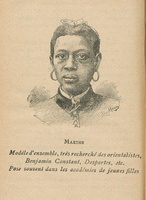
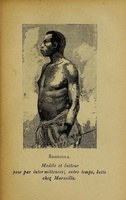
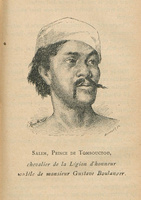
The presence of Black models in Paris has been well known to art historians. As Hugh Honour noted, painted têtes d’études (studies of heads) after models of diverse ethnic types—including Blacks—were a popular genre early in the nineteenth century.[2] The prevalence of studies of Black models from the Second Empire and Third Republic suggests that artists routinely continued to undertake such efforts—probably as an exercise in replicating darker skin tones and an African phenotype.[3] The varied features of the figures in these works suggest that there were a number of Blacks posing in Parisian studios, but the names and histories of these men and women are largely unknown (figs. 4, 5).
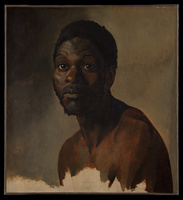
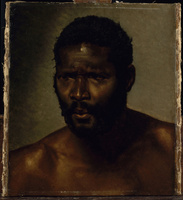
In one sense, this is hardly surprising: the names of models were routinely omitted from public or official records in the nineteenth century. The École des Beaux-Arts preserves numerous drawings produced for the annual competitions leading up to the Prix de Rome; the names of the students who made them are recorded alongside the identities of the professors under whom they studied, but the names of the models who posed are absent.[4] Working in their own studios, artists might jot the names of the models who posed for them on the margins of drawings, their atelier walls, or lists they shared with other artists, but rarely did they name their models when they wrote their memoirs. Performing for an audience of one, a model’s identity was eclipsed by that of the figure whom they impersonated on the model stand.
Dollfus’s catalogue of models’ names and biographies—however brief—disrupts that practice. He was responding to growing popular curiosity about the men and women—especially the women—who posed behind closed studio doors. Claire O’Mahony has shown that in the 1880s and 1890s, studio scenes featuring the contemporary model—a rare subject for Salon paintings earlier in the century—became commonplace on the walls of annual exhibitions.[5] During the same period, journalists who frequented Parisian studios, like Hugues Le Roux (1860–1925) and Charles Virmaître (1835–1903), began to describe in the popular press the presence of a substantial class of professional models.[6] Dollfus’s volume was simply the most exhaustive example of the genre. Curiosity about the lives and identities of women like Victorine Meurent (1844–1927) and Suzanne Valadon (1865–1938), who posed for canonical modernist artists, has persisted from the end of the nineteenth century to the present.[7]
In recent years, efforts to decolonize and decenter the discipline of art history and to shift the focus away from the traditional emphasis on mostly white and male artists and patrons has furthered an upsurge in scholarly efforts to put names to the faces of Black models within nineteenth-century representations.[8] The roster of Black models has grown to include Joseph (ca. 1793–ca. 1865), who came to France from Saint-Domingue and posed for Théodore Géricault’s (1791–1824) Raft of the Medusa (1818–19; Musée du Louvre, Paris);[9] Aspasie (dates unknown), who posed for Eugène Delacroix (1798–1863);[10] Laure (dates unknown), best known from her appearance in Édouard Manet’s (1832–83) Olympia (1863; Musée d’Orsay, Paris);[11] and Seïd Enkess (ca. 1821–death date unknown), who posed for Charles-Henri-Joseph Cordier (1827–1905), among others.[12]
These inquiries offer important alternative perspectives on familiar artworks and illuminate the place of Africa and persons of African descent in the French imagination during the decades from the brief period of the abolition of slavery in the French Revolution to slavery’s final elimination in French territories and into the colonial era. Situating Africans within the nineteenth-century imaginary, scholars have explored representations of Blacks as the exotic, Oriental other and as ethnographic specimens.[13] Equally productive, other studies have explored Black models’ lived experience, revealing how patterns of artistic production were shaped by the structural racisms within French society.[14] This approach can be framed as a form of “art history from below,” adapting the catchphrase popularized by E. P. Thompson, who called for a methodology that sets aside histories of state institutions and great men to focus on common people.[15] In The Making of the English Working Class, Thompson explained that his aim was to understand the perspectives and actions of groups relegated to the periphery in more traditional historical accounts, and to “rescue” actors from the past “from the enormous condescension of posterity.”[16] Arguably, traditional art history’s emphasis on artists, patrons, critics, and audiences has condescended to the contributions of the men and women on the model stand who comprised a sizable group within the nineteenth-century Parisian art world.
This article is an effort to piece together the history of one of the Black models named by Dollfus: Salem. Tracing his path from Africa to France, it explores intersections between Parisian practices of artistic production and the social and institutional structures of French colonialism at the end of the nineteenth century. Using Salem as a case study, I aim to show that paintings and sculptures representing Blacks that were displayed at the Salon, where they were admired by visitors, analyzed by critics, and sought after by patrons, were produced through the collaborative efforts of usually nameless men and women from marginalized, often immigrant groups, whose presence in the metropole was integral to the growing racial and cultural heterogeneity of the city. The scraps about Salem’s life that remain in the archives reveal patterns of tension between French and North African cultures and highlight the contradictions in the French colonial enterprise. Salem’s trajectory from Africa to France began in the military, where he served among the Indigenous troops who were recruited to facilitate the French subjugation of Algeria and were later honored for their service against European enemies. In Paris, he was a Black colonial subject posing for white artists whose representations of distant battles and exotic lands perpetuated racist and imperial ideologies. But for Salem and other migrants, the métier of the pose enabled them to establish a foothold, however tenuous, within the Parisian metropole, anticipating the experiences of the large numbers of migrants who would follow them across the Mediterranean in the twentieth and twenty-first centuries. At the same time, the practice of the pose, which required exposing one’s body, sometimes naked, to the regard of others, may have forced immigrant models to abandon their cultural and religious norms or else to develop compromises with their “employers” that would relax the obvious cultural tensions between white French artists and culturally or racially “other” models.
Salem and the Métier of the Pose
The community of models in nineteenth-century Paris included a large proportion of “outsiders”—immigrants and members of marginal ethnic groups, such as Jews and Roma.[17] In 1886, the daily newspaper L’Intransigeant summarized a survey, conducted by an unidentified official agency, of female models who posed for Parisian painters, sculptors, and photographers.[18] Six hundred seventy women were interviewed. Only a sixth were born in France; about a third were Italian, and the balance were from various foreign countries, including Germany, Switzerland, Spain, Belgium, England, Ireland, the United States, Portugal, and Austria-Hungary. Blacks, too, were among the alien groups working in Parisian studios, but their numbers were small. The Parisian census of 1891, which listed the population of the city at 3,113,674, counted only 205 Africans.[19] This was a much smaller proportion of the inhabitants than had been recorded in 1833—before the abolition of slavery—when the census listed 350 Blacks within a population of just under one million. In contrast, the community of Italian models in 1891 was sizable: the census listed 26,821 Italian immigrants in the city, and in the same period the number of Italian models was estimated at twelve hundred.[20]
Tracing the history of models of any origin presents challenges, but Salem’s name appears regularly in the annals of Parisian studios from the final quarter of the century, indicating that he posed in a variety of ateliers, including official institutions and private teaching studios as well as those of individual artists. Dollfus identifies Salem as a model for Gustave Boulanger (1824–1888), so he may well have posed for the red-crayon drawing known as Study of Man in Turban and Loincloth now in the collection of the Museum of Fine Arts, Boston (fig. 6). The work served as a preparatory study for The Appian Way in the Time of Augustus, a painting exhibited in the Salon of 1874 that is now known only through reproductive prints (fig. 7).[21] The finished work, which showed the ancient thoroughfare crowded with men and women in Roman togas driving chariots and carried in sedan chairs alongside warriors parading on horseback, centered on a trio of Black men—quite possibly all based on Salem. The painting warrants further exploration, and I will return to it after considering Salem’s history.
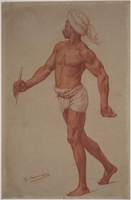
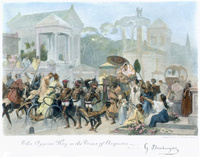
Two years later, Salem posed in the teaching studio of Edouard Krug (1829–1901), where he was drawn by the American art student May Alcott Niericker (1840–79), who described him in a letter to her family:
When he [adjunct instructor Carl Müller] came to my drawing of a full-length negro, who is really the Prince of Timbuctoo, and such a splendid specimen of a man that he looks very princely, Müller said ‘with what passion & enthusiasm you draw this ensemble,’ it is very vigorous and shows your interest and not scorn of this race.[22]
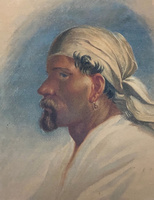
The académie (nude figure study) that Niericker drew of Salem is lost, but her watercolor portrait of him, titled Crimean War Veteran, shows a bearded profile of a man with an earring and a headscarf (fig. 8). Niericker’s letter continued:
I had freely expressed my admiration for him [the Black model], beside fighting the battle of the blacks versus whites, whenever the question came up between the Southerners, of whom there are three in the class, & two of us Northerners. I am proud that he proved my part of the proposition as most true, for he is the most gentlemanly, polite, and delicate model that we have had. He was in the Crimean War & showed us four great scars on his legs, where he was wounded, and Mr. Krug told us he was decorated for his courage, and considered one of the best models in Paris.[23]
As Julia Dabbs shows, Niericker’s response to Salem—her desire for social justice and freedom for Blacks and her effort to look beyond widespread stereotypes of Black men to the individual on the model stand—was bound up with her family’s experience of the Civil War and abolitionist sympathies.[24] Salem’s presence in Krug’s studio, Dabbs suggests, was a “cultural trigger” for the American students, provoking ongoing debates between those who identified with the North and the South and perpetuating issues that remained unresolved in the American context a dozen years after the end of the war.
Teaching studios were an important source of employment for Parisian models, but their hiring criteria differed. In 1878, Salem was listed among the models for the École des Arts Décoratifs, and after 1900 he was included in a registry of models posing for the École des Beaux-Arts.[25] Records for the École des Beaux-Arts, though inconsistent and incomplete, provide a rough sense of the origins of models hired throughout the nineteenth century and suggest that Blacks posed infrequently for the school before 1900. In 1832, Joseph “le nègre” (the Black) was one of three models hired to pose regularly, but by the Second Republic immigrant Italians, who were seen as descendants of the men and women who posed for canonical antique and Renaissance works, had become the favored models in the school.[26] The École’s archives of drawings and paintings produced for the annual competitions leading up to the Prix de Rome—which include images of men of various ages, from lithe adolescents to bearded patriarchs—include no Black models.[27] Were Blacks not thought to embody the beau idéal (perfect type)? Or were white Europeans implicitly associated with the historical and religious narratives selected as the basis of the Prix de Rome competitions? Black models were more routinely hired to pose in the private teaching studios that proliferated in Paris in the late nineteenth century and attracted students whose aspirations were not restricted to history painting. In 1867 at the Académie Suisse, Paul Cézanne (1839–1906) produced a study of the man identified as Scipion.[28] In 1882, Barclay Day (1839–1913), who studied in Léon Bonnat’s (1833–1922) popular atelier, recalled: “We had negro models whose dark and shining forms, as they stood silent and motionless, made one forget for the moment that it was not an actual bronze from which one was working.”[29]
The connection that Day drew between skin color and sculptural material perpetuated a well-established equation in which the white marble of antique works was—in the words of Mechthild Fend—“frequently confounded with the imagined whiteness of the models.”[30] Within neoclassical aesthetics as articulated by Johann Winckelmann (1717–68) and reinforced by the emerging discipline of racial anthropology, the whiteness of stone served as a marker of physical, moral, and social superiority. With the rise of Orientalism, Cordier and other sculptors reinvigorated the ancient tradition, revived in the seventeenth century, of employing polychrome materials to represent Africans and Asians.[31]
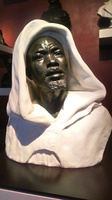
Salem also may well have posed for two works by Paul Loiseau-Rousseau (1861–1927): Salem, nègre de Soudan (Salem, Black from Sudan), a portrait bust in the Orientalist tradition exhibited at the Salon of 1879, and a sculpture of a seated musician today found in the garden of the Africa Museum (formerly the Royal Museum for Central Africa) at Tervuren in Belgium (fig. 9).[32] There were surely other works and other institutions for which he posed, but the existing records confirm that Salem was a model in demand in the teaching studios and private ateliers where the academic tradition and Orientalism flourished.
What was Salem’s history and how did he come to the studios of Paris? Each of the descriptors listed by Dollfus—“Prince de Tombouctou, Chevalier de la Légion d’honneur, modèle de monsieur Gustave Boulanger”—needs to be explored.
Salem as Tirailleur Algérien
Salem’s military service is confirmed by a letter of 1910 written in response to an anonymous study of artists’ models entitled “Nos artistes et leurs modèles: Autour de la table de pose” that appeared in the popular journal Lectures pour tous and included details that reiterate Dollfus’s earlier account.[33] The letter, signed by a veteran of the Franco-Prussian War, asks:
Wasn’t this Salem the Black drum major bearing the same name whom I saw in 1870 in Nantes, at the head of one of the battalions of the Garde nationale mobile de la Loire-Inférieure (which I believe was called the Candeau battalion) and who characteristically wore a white turban which played up his lively Black face? Salem took part with my battalion in the defense of Paris and distinguished himself there enough to be awarded the Légion d’honneur.[34]
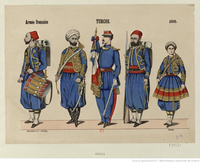
The turban of the veteran’s recollection and the soft cap worn by the model in the portrait in Dolfuss’s volume both evoke the headgear worn by the Régiment de Tirailleurs Algériens of the Armée d’Afrique—popularly known as Turcos—and suggest that before he became a model Salem had indeed served in the French military (fig. 10). Tracking the particulars of Salem’s engagement as a tirailleur, however, presents difficulties similar to that of tracing his history in Parisian studios. Models were often known only by a given or family name, and Dollfus did not provide Salem’s full name. Regimental histories of tirailleurs algériens from the late nineteenth century make note of a number of men whose name was “Salem” and whose exemplary performance or elevated rank were significant:[35] Salem ben Guibi, who captured a fanion (banner) in the Mexican campaign, was promoted to first lieutenant, and died in 1870; Brick ben Salem, who rose to the rank of lieutenant, was wounded in 1870 and retired in 1875; Meçaoud ben Salem, a first lieutenant, served in France’s Italian campaign; Kara ben Salem, a bugler, was wounded in 1851 and saved a fallen comrade in 1870; Salem Bessari was killed in 1851; and Salem ben Mohammed was singled out in 1869 for outstanding service in Algeria. Surely there were other rank and file tirailleurs named Salem whose service did not merit their inclusion in these chronicles.
Tirailleurs were among the Indigenous forces that the French relied on when they invaded Algeria in 1830, as these men knew the rugged terrain and culture and were less susceptible to diseases such as malaria and yellow fever.[36] Before the French conquest, the Zouaouas, a Berber ethnic group from the Kabyle mountains, had served the Ottoman rulers as mercenaries, and the French continued the practice, dubbing the troops Zouaves.[37] They fought under French officers until 1841, when Zouave units were limited to Europeans and Indigenous soldiers were regrouped as Tirailleurs indigènes d’Algérie.[38] The force included three battalions—one for each of the Algerian provinces—of 1,781 men.[39] In 1852 they were officially constituted as part of the Armée d’Afrique. Like Zouaves, tirailleurs algériens wore baggy saroeul or sirwal trousers, and vests and jackets decorated with braid. Their uniforms were distinguished by their color: sky blue trimmed with yellow braid, a broad red cummerbund, and a white turban or red chechia, the soft hat worn widely in the region.
The French continued to recruit tirailleurs among the Berbers of Kabylia, whose vigorous resistance to colonial forces earned the colonizers’ admiration, but they also enlisted men from other Algerian ethnic groups: Kouloughlis, who were descended from Arabs who had married Turks during the period of Ottoman rule, and Blacks, who were the descendants of formerly enslaved Africans freed after 1848.[40] Most were from the impoverished lowest classes and welcomed the pay of one franc per day. Although terms of enlistment were fixed at five years, this was not strictly enforced: some men deserted and others were discharged at the will of their French officers.[41] They were scorned by Muslim Arabs because they served unbelievers.[42] But the French considered Indigenous enlistees who committed to military service to be good soldiers: they were reputed to be courageous and disciplined fighters who obeyed orders, looked on the regiment as family and didn’t complain of privations.[43] A few advanced to the rank of lieutenant, but the higher ranks were reserved for French citizens.
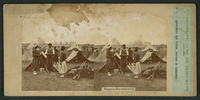
Initially tirailleurs served in the continuing conquest of Algeria, but in 1854 a volunteer corps was sent to Europe to serve in the Crimean War, where the Russians dubbed them Turcos because of their red headgear.[44] Their significant contribution made them integral to Algeria’s emergence as a model colony considered part of “greater France.”[45] After participating in the Italian campaign in 1859, they were stationed outside Paris at the Camp de St. Maur in Vincennes (fig. 11). The Third Battalion was active in the Second French Intervention in Mexico in 1863; in recognition of its valor the unit was decorated with the Légion d’honneur and incorporated into Napoleon III’s Imperial Guard which stood watch at the Tuileries Palace.[46] With the outbreak of the Franco-Prussian war, all three regiments were sent to France, where they fought at Wissembourg and Woerth.[47] Casualties were extreme: of 1,905 men serving in the Second Regiment, 815 were killed and 812 wounded. Survivors were reconstituted into provisional battalions; some went on to fight in Metz, while others—who would have included Salem—joined the Army of the Loire. Some were active in the defense of Paris, but whether they participated in the Commune is less certain.[48] At the close of the war, most seem to have returned to Algeria, but a few settled in France, anticipating the large wave of Algerian immigration to France that would mark the twentieth century.[49]
It was not unusual for colonial subjects to be honored with the Légion d’honneur, but the histories of the few “Salems” who were distinguished by the award at the close of the nineteenth century do not align with the model’s trajectory.[50] Abdel Kader ben Salem, who was born in Tebessa in the Algerian province of Constantine in 1840; served in the third regiment of tirailleurs beginning in 1860; rose to the rank of lieutenant during service in Algeria, Germany, and Tunisia; and was named to the Légion d’honneur in 1889. Salem ben Guerba, born in 1835, was caid (commander) of a Berber clan from Oulad-Dris and an ally of the French army in northeastern Algeria; he was named to the Légion d’honneur in 1872. Si el Hadj Salem el Kadraoui, who was born in Kairouan, Tunisia, rose to the rank of captain in the First Mixed Company in Tunisia and was named to the Légion d’honneur in 1884.
So, while Salem likely served in the Armée d’Afrique, his claim to the Légion d’honneur is suspect. Was he simply passing himself off as a hero, or was he perhaps claiming for himself a distinction that had been accorded the regiment in which he served? The reasons an African veteran might claim such an honor are not hard to fathom. When tirailleurs algériens were initially stationed in France in the early 1860s, Parisians looked on them with curiosity and suspicion. As Elizabeth Childs has discovered, caricatures of them in French newspapers mingled fear, mistrust, and fascination.[51] In the aftermath of their service in the Franco-Prussian War, their reputation as ferocious fighters was acknowledged.[52] While some continued to consider them “savage beasts,” whose courage on the battlefield was simply a sign of vicious primitive instincts, to others the valor of Indigenous soldiers in French military uniforms was emblematic of the mission civilatrice (civilizing mission) that underlay the country’s colonial enterprise.[53] As Sylvie Chalaye argues, the uniform of the tirailleur transformed the Black soldier into a Frenchman: “the Black soldier enlisted in the French army was a newcomer to civilization, who would defend it with his life.”[54] This was the identity which Salem was claiming: he was not a French citizen, but he was a French hero.
Salem as Model Soldier
Salem’s introduction into Parisian studios most likely occurred in the 1860s, after the Crimean War, when Turcos bivouacked in the Bois de Vincennes were called on to pose for photographers and painters. Jacques-Philippe Potteau (1807–76), who produced a photographic record of diplomats and other foreign visitors passing through Paris as part of a study of “ethnographic specimens” for the anthropology department of the Muséum National d’Histoire Naturelle, posed a number of tirailleurs in their uniforms and their medals.[55] On the mounts, Potteau noted the men’s names, brief descriptions, places of birth, and parentage (figs. 12–14). In the same period, artists who were awarded commissions for paintings celebrating French victories in the Crimean War, destined for the galleries of the Museum of French History at Versailles, turned to the Turcos encamped at Vincennes for models.[56]
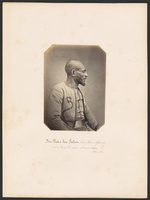
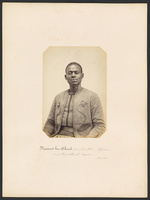
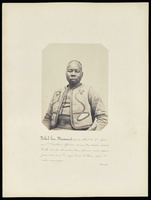
During the four years that Isidore Pils (1813 or 1815–75) worked on La Passage de l’Alma, 20 septembre 1854 (Battle of Alma, September 20, 1854), which was exhibited at the Salon of 1861 and photographed by Pierre Ambroise Richebourg (1810–75), he spent time at the camp (fig. 15). Adapting the traditional studio practice he had learned at the École des Beaux-Arts, he produced painted études (studies) of individual soldiers. One study, recently sold at auction by Sotheby’s, shows two Turcos, recognizable by their costumes (fig. 16). In the final composition, they became part of a crowd of soldiers slogging through the water in the foreground.
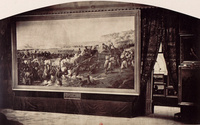
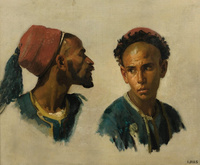
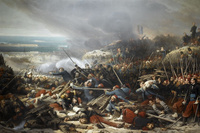
When Adolphe Yvon (1817–93) was engaged to represent the Battle of Malakoff for the galleries at Versailles, he was sent by the government to study the battle fields.[57] Ultimately he produced three paintings: La Prise de la tour de Malakoff, 8 septembre 1855 (Taking of the Malakoff, September 8, 1855), 1857; Combat dans la Gorge de Malakoff, 8 septembre 1855 (Battle in the Gorge of the Malakoff, September 8, 1855), 1859; and La Courtine de Malakoff, 8 septembre 1855 (The Courtine of the Malakoff, September 8, 1855), 1859. Combat dans la Gorge de Malakoff features Turcos, identifiable by their sky-blue jackets and distinctive headgear, as well as Zouaves in red pants and dark blue jackets (fig. 17). In the foreground at the center of the composition, two Turcos crouch behind a gabion as they take aim at the enemy while a third grasps at a stake, getting ready for hand-to-hand combat. In developing this work, as in preparing for other works, Yvon’s preparatory drawings included likenesses of individual officers and studies of the twisted and foreshortened attitudes of enlisted soldiers.[58] Since the painter had been given the commission for this work after the success of the first painting in the series at the Salon of 1857, these figures were likely executed in Paris from models drawn from among tirailleurs bivouacked outside the city.
The prominence given to the tirailleurs in the works of Pils and Yvon reflects a shift in the traditions of French military painting. While in earlier decades artists had highlighted the heroism of officers, by the Second Empire they increasingly sought to address the realities of the modern battlefield. Enlisted soldiers continued to be depicted as subordinate to the generals but were more prominent in the compositions.[59] They were presented as individuals and active participants in the battle, and the artists’ detailed renderings of their attitudes and faces brought the realities of conflicts home to Parisian viewers. As Théophile Gautier (1811–72) put it reviewing Pils’s work, “He puts a soul beneath their uniform and gives each one a character. His heads are not, as one says, têtes de chic [formulaic or stereotypical heads]; they represent a human individuality, while entirely keeping the military stamp.”[60] For artists, the presence of African soldiers who were willing to pose must have been a welcome resource that lent authenticity to scenes of distant combat and military forces that for the first time included French colonial subjects. For the men whose faces appeared in the paintings, posing would have presented an opportunity to supplement their salaries and an introduction into the unfamiliar atelier culture of the metropole.[61]
Salem as “Prince de Tombouctou”
When posing in Parisian ateliers, Salem was associated not only with the French military but also with a specific African location: Tombouctou. As a soldier in the Armée d’Afrique, his origins were more likely in North Africa than in the region of modern Mali, where Tombouctou is located.[62] But as a nom de pose (assumed studio name), the title “Prince of Tombouctou” served to distinguish him from other Black models. Designations of this sort were not unusual in the Parisian modeling community. During the July Monarchy, the model Cadamour (birth date unknown–1846) styled himself “le roi des modèles” (the king of models) and had a card printed with this title to distribute to artists.[63] Thomas Bokowski (dates unknown) was widely known in studios as Thomas l’Ours because when he had no work as a model he tussled with bears in a sideshow.[64] Bamboula’s (dates unknown) name likely came from his time in the wrestling ring, where the name was used by several wrestlers, although his name carried derogatory racist associations.[65] Some models were known by their origins: Brzozomvsky (dates unknown), who posed for Jacques-Louis David (1748–1825) and the École des Beaux-Arts, was known as Polonais, since his name was so difficult for the French to pronounce.[66] Was Salem’s nom de pose one he adopted himself or one bestowed upon him by the artistic community? Other models inflated their histories. Late in his career, Charles Alix Dubosc (1797–1877), who began posing in the studio of David in his early teens and went on to pose in the École des Beaux-Arts, claimed to have posed for several well-known works from earlier in the century—including Anne-Louis Girodet de Roucy-Trioson’s (1767–1824) Sleep of Endymion (1791; Musée du Louvre, Paris), which was painted while the artist was in Rome, where Dubosc had never traveled.[67]
Salem’s claim to be from Tombouctou would have seemed plausible, since France’s colonial empire was expanding into West Africa, even though the city was not under French control at this time.[68] The other Black models listed by Dollfus—Marthe and Bamboula—were said to be from Senegal. Equally important, Tombouctou had resonance for the French. Tales of the city as a site of fabulous wealth and Islamic learning dated to the publication in 1550 of Leo Africanus’s Descrittione dell’Africa (Description of Africa) and had made it a focus of later Europeans’ explorations of the continent. René Caillié’s mission finally reached the city in 1828–30, but he reported that it was merely a faded outpost.[69] Until the French army took control in 1894, Tombouctou was known primarily for its remoteness.
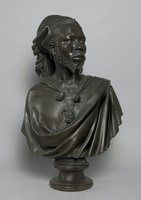
Artists working in Paris might well recall the bust of another African man that Cordier exhibited as Nègre de Tombouctou (Black from Tombouctou) at the Salon of 1850 (fig. 18).[70] Cordier’s model, Seïd Enkess, was a former slave who had been born about 1821 in the region of Mayak (perhaps now known as Mayak’elo in Dire Dawa, Ethiopia) to the southeast of Sennâr and Darfur, in northeastern Africa—far from Tombouctou. As a child he had been captured in a slave raid and was sold in Cairo, and after passing through several owners was brought to France. By 1840 he was established as an artist’s model. Cordier, who may have encountered Enkess in the studio of François Rude (1784–1855), first exhibited a plaster bust of him as Saïd Abdallah, de la Tribu de Mayac, Royaume de Darfour (Saïd Abdallah from the Mayak Tribe, Kingdom of Darfur) at the Salon of 1848—the same year that France abolished slavery throughout the nation and its colonies. The work made Cordier’s reputation, and two years later, capitalizing on its popularity, he recast the bust and exhibited it under the title Nègre de Tomboucktou. As James Smalls argues, this deliberate change in title, substituting a geographical designation for a personal name, transformed “a portrait of a unique (former) slave individual into an aesthetically stunning generic ‘specimen’ of racial and cultural difference.”[71] The slippage from an individual likeness to a generic specimen erased Enkess’s individual history and identity and transformed the former slave-turned-artists’-model into an archetype of otherness.
But like Salem’s claim to be the recipient of the Légion d’honneur, the title “Prince of Tombouctou” asserted a persona and an identity. As an immigrant and a colonial subject, the nom de pose would have set him off as originating in Islamic culture and would have aligned him with the exoticized figures represented in Orientalist scenes. It may have served to promote his services as a model to artists like Boulanger or Cordier, who specialized in the genre. It also points to a shift in his engagement with and practice of the pose. Tirailleurs posing for military paintings performed as themselves, maintaining their professional identities to reenact historical events with which they were associated, if not the specific battles in which they participated. Entering the Parisian studios of Boulanger or Krug, Salem was expected to remove his uniform and history and to assume other costumes and identities.
Salem as Parisian Model
Dollfus identifies Salem as a model for Boulanger, and it seems probable that he is represented in the study by Boulanger in the Museum of Fine Arts, Boston (see fig. 6). Stripped of his uniform—except perhaps the turban—and wearing a loincloth, Salem assumes an energetic attitude, as though he is striding forward. His profile in the drawing, which reveals his beard, mustache, and blunt nose, resembles the likeness reproduced in Dollfus’s book as well as the man represented in Loiseau-Rousseau’s sculpture (see figs. 3, 9). Firmly establishing the identities of models based on artworks for which they may have posed is tricky: Julia Dabbs notes that she did not initially connect the figure in Niericker’s watercolor with the man described in her letter (see fig. 8) because of his lighter skin tone and the tendrils of hair emerging from his headscarf.[72] Dabbs speculates that, in conformity with the popularity of Orientalist subjects, the US art student may have sought to reshape the model into an exotic Middle Eastern or North African character. Representations of Turcos include men with a range of skin tones and phenotypes associated with both North Africa and the area of West Africa known in France as the Sudan, but whatever his specific origins, the Prince de Tombouctou was identified as Black by Dollfus, by the French soldiers with whom he served, and by Niericker and her fellow students.
The painting for which the Boston drawing served as a preparatory study—The Appian Way in the Time of Augustus—was typical of “historical genre” paintings popularized by neo-Grec artists at midcentury (see fig. 7).[73] Boulanger’s early travels in Algeria, where he spent time because of his health, first sparked his interest in Orientalist subjects.[74] Later, after studying under Paul Delaroche (1797–1856), he was awarded the Prix de Rome by the École des Beaux-Arts, and during his sojourn in Italy he studied the ruins of Pompeii. Like his close friend and colleague Jean-Léon Gérôme (1824–1904), with whom he traveled to North Africa in 1872, Boulanger gravitated towards Orientalist and classical subjects, which he rendered in the academic tradition.
The Appian Way in the Time of Augustus shows a crowd parading along the ancient Roman thoroughfare on foot, horseback, and in a sedan chair. The Roman context is established by the tombs that line the street and the togas worn by most of the throng, but details like the Ottoman armor worn by the horsemen on the left of the canvas infuse it with an Orientalist undertone. To some Salon visitors in 1874, the colorful crowd also evoked familiar scenes: several critics compared the throng in Boulanger’s painting to modern crowds parading on the Champs-Elysées after horse races in the Bois de Boulogne.[75] Boulanger’s painting, in their view, equated the extravagances of ancient Rome with those of modern Paris.
At the center of the final composition, a trio of Black men clear the route for a woman carried by porters in a sedan chair. They are similar in build and height, suggesting that Salem may well have posed for all three. Loincloths and jewelry enhance their muscular bodies and distinguish them from others in the crowd wearing togas or armor. The only other partially clad figure is a young Black woman who stands behind the woman in the sedan chair, holding a feathered fly whisk. The seminudity of these four figures as much as their dark skin color marks them off and declares their enslaved status. Boulanger was aware that in ancient Rome slavery was not invariably associated with people of African descent: when he painted scenes of ancient slave markets he included among the enslaved figures pale-skinned blonds and redheads as well as Blacks.[76] But his paintings of classical themes often included enslaved Blacks, typically female, like the women who figured frequently in Orientalist harem scenes.[77]
The costume which Boulanger contrived for the three Black men—loincloth, anklets, bracelets, pectoral harnesses, and a headband—underlines both their enslaved status and their “primitive” character. Their elaborate trappings, consisting of a choker and metal straps which cross over their chests, support round medallions from which project crescent shapes. While the crescents might suggest Islamic motifs, the medallions recall phalerae: ornamental discs which decorated Roman legionary armor and the harnesses of cavalry horses.[78] In effect, Boulanger’s image likens the enslaved Black men to animals.

The men’s decorative jewelry also recalls the ornate costumes worn by blackamoors in the traditions of European decorative arts (fig. 19).[79] The sculptural tradition of the blackamoor, which originated in the sixteenth century, incorporated idealized figures of Blacks in exotic dress into furniture, tableware, and interior decoration produced for a luxury market. Such figures equated enslaved colonial labor as a source of wealth with the enslaved Black as a luxury good to gratify the European taste for exoticism through an image of the Black laboring body. As Adrienne Childs has put it: “the trope of the black servant in European art . . . had become a ubiquitous symbol of exoticism and luxury.”[80] By 1874, the date of Boulanger’s painting, the slave era had given way to colonialism in France, but the trope of the blackamoor, which enjoyed a new vogue with the rise of Orientalism, continued to signify luxury and excess. Boulanger’s three Black men, their muscular bodies ornamented with jewelry, are blackamoors come to life, enslaved Blacks who serve as decorative accessories and signs of the luxury and extravagance of Roman culture.
The loincloth worn by Boulanger’s trio of Blacks is a costume that appears in other images of Africans during the period. An early example is the garb worn by the kneeling Black figure in the antislavery medallion designed in the late eighteenth century for Josiah Wedgwood and used by abolitionist campaigns in England, the United States, and France (fig. 20).[81] In the nineteenth century, Black men wearing loincloths appear in works commissioned for the Muséum National d’Histoire Naturelle, which purported to present an anthropological view of “primitive” Africans—including Charles Arthur Bourgeois’s (1838–86) Le Charmeur du serpent (Snake Charmer) of 1864 (fig. 21) and Le Chasseur de crocodiles (Crocodile Hunter) of 1883 as well as Ernest Barrias’s (1841–1905) Les Nubiens ou Les Chasseurs d’alligators (The Nubians or the Alligator Hunters) of 1894 (fig. 22).[82] Loincloths are also worn by Black figures in allegories of slavery and its abolition: in both Yvon’s Genius of America (fig. 23), a scene of reconciliation following the American Civil War that was exhibited in 1870, and Barrias’s Libération des noirs (Liberation of the Blacks), a monument to Victor Schoelcher from 1896, the contrast between the loincloth worn by formerly enslaved Africans and dress worn by the Europeans marks the Black men as “primitive” in nature (fig. 24).[83]
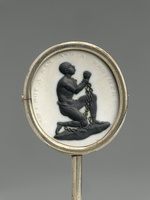
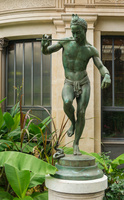
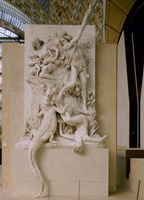
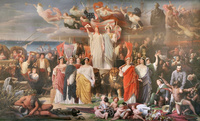
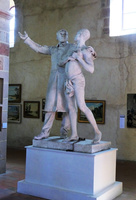
Salem’s Loincloth in Islamic Traditions
Boulanger’s drawing for the Black figure in The Appian Way in the Time of Augustus and a painted study by Yvon for the formerly enslaved man in his allegory of the postbellum United States both show the models—Salem and an unidentified man who resembles Salem—wearing loincloths, as they would appear in the finished paintings (figs. 6, 25). Traditional academic practice, the foundation of the curriculum that Boulanger and Yvon would have learned and later taught in the École des Beaux-Arts, called for initial compositional sketches to be followed by preliminary studies of individual figures posed in the nude.[84] Only once the conjunction of anatomy and gesture were well understood would artists represent figures in the garb they would wear in the final painting. This was the method that Théodore Chassériau (1819–56) followed in 1836, when at the request of Jean-Auguste-Dominique Ingres (1780–1867) he prepared a nude study of Joseph, the Black model who had come to Paris from Saint-Domingue (fig. 26).[85] Later in the century, artists working in the academic tradition, like William-Adolphe Bouguereau (1825–1905) and Gustave Moreau (1826–98), continued the practice, working from nude models even when decorum dictated that in their final paintings the figures’ genitals would be discreetly covered by drapery.[86] In teaching studios, whether the École des Beaux-Arts, the Académie Julian, or private ateliers, models continued to pose nude. Costumed or partially nude models were typically relegated to the studios where women studied, in deference to conventions of feminine modesty.[87]
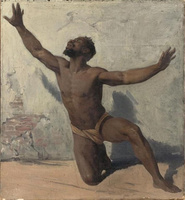
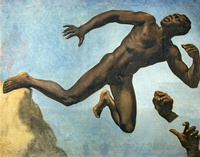
Yvon’s and Boulanger’s deviation from the routine practice of posing male models completely nude may have reflected, I propose, their African models’ preferences. In contrast to Joseph, born in Saint-Domingue, Salem and other Black models working in Paris later in the century were born and raised in the predominately Muslim cultures of North and West Africa. Their attitudes towards nudity may have been shaped by Islamic beliefs and customs.
In the academic tradition and Parisian studios of the nineteenth century, the nudity of male models was tied to the beau idéal and conceptions of heroic masculinity that originated in the culture and art of ancient Greece. Masculine nakedness was routine in the gymnasia and symposia of Greek quotidian life and was an important aspect of Greek identity.[88] As a marker of Greek civilization, it contrasted with the mores of Near Eastern cultures in which nudity was linked to vulnerability and shame. With the rise of Christianity, the associations of nudity became more complicated: in the Abrahamic tradition it was inseparable from the narrative of sin and the Fall. As Jill Burke has shown, with the rise of the European Renaissance, the nude figure gradually came to be accepted as a signifier of both essential humanity and artistic creativity, and drawing from the nude became a rudiment of artistic success and integral to artistic training.[89]
Within Islam, however, the Abrahamic association of nudity and shame continued to prevail. The tradition of awrah refers to the areas of a man’s or woman’s body that must be kept hidden while performing religious duties or when in the presence of other people, except for a spouse. In some schools of Islamic thought, men are called upon to keep covered the area from the navel to the knee; in others awrah extends over the navel.[90] According to the Prophet, “A man should not look at the awrah of another man, nor a woman of a woman.”[91] Clothing, in the Koranic injunction, was intended to maintain modesty: “O children of Adam! We have revealed unto you clothing to conceal your shame” (Sura 7:26).[92]
Yedida Kalfon Stillman describes the basic Islamic costume as historically and geographically consistent. From the beginnings of Islam it consisted of “an undergarment, a body shirt, a long dress, gown or tunic, and an overgarment, such as a mantle, coat or wrap, footgear and a head covering.”[93] The izar, a long sheet-cloth worn as a mantle, waistcloth, or loincloth, was the basic undergarment for men in Arab traditions even before Islam.[94] Known also as a m’izar, it later became associated in northern Africa with the draped costume known as a haïk.[95]
This dress continued to be worn in North Africa into the nineteenth century. When Carl Hagenbeck arranged for an “ethnographic display” of Nubians at the Paris Jardin d’Acclimatation in 1878, the Africans’ dress was described by H. A. Mazard of the Société d’Anthropologie de Paris: “They are uniformly dressed in loincloths and an unbleached cotton drapery that usually leaves the upper part of the body uncovered.”[96] Descriptions of Algerian dress are consistent, although—likely out of decorum—they do not describe undergarments. In 1837, R. Jungmann, a Polish refugee who had served in Algeria with the Armée Français, explained that Bedouins, Moors, and Kabyles, who comprised the Arab population of the colony, all wore a similar costume:
Their clothing consists of 1. The haïk, . . . one of the four ends of which is thrown over the head and tied with a cord (reit) made of camel hair; 2. the burnous, a kind of wide coat, of white wool and in one piece, it is furnished with a hood serving to cover the head, shaved everywhere, with the exception of the crown, surmounted by a tuft of hair. It is only the rich who wear wide trousers, reaching to the knees, their arms and feet are bare: some tribes, however, wear a kind of sandals.[97]
As the French conquered additional Algerian territory, they came to distinguish between Arabs and Berbers, who were later identified with Kabylia.[98] In the French view, Berbers were only superficially Muslim and were socially and biologically closer to Europeans.
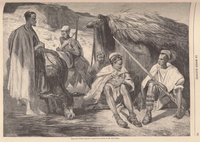
Although the French traded with Kabyles and recruited them to serve as tirailleurs, French assertion of control over their mountainous homeland proved difficult.[99] For two decades the inhabitants effectively used guerilla tactics to resist colonial incursions. When French military forces attacked villages, Kabyle warriors retreated to rocky gorges, where they could easily fend off the invaders. In 1857—when the French finally conquered the mountainous region—Jules Rigo described the Kabyle costume for readers of Le Monde illustré: “The Kabyle, whether in snow or the sun, is generally bare headed. Those who border the plains sometimes wear the chachia [sic]. His only clothing is a kind of woolen shirt (chelouhha) that goes beyond the knees and wears the burnous when his means permit.”[100] The illustration that accompanied the description shows a group of men dressed in loose, knee-length robes clasped at the neck as they squat and stand before a domestic structure (fig. 27).
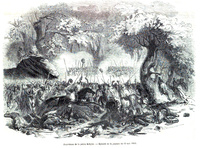
News reports of French troops’ final conquest of Kabylia include references to Kabyle costumes. Émile Carrey, who had explored Peru and the Amazon for the French Ministères des Affaires Étrangères et de la Marine, was embedded with the military for the campaign; chronicling his experience in Récits de Kabylie: Campagne de 1857, he described Kabyles as wearing white burnous.[101] Images of the battles between the French and Berbers published in journals like L’Illustration emphasize the fierce brutality of Kabyle warriors, some clad in burnous, while others wear sleeveless gandouras (tunics) (fig. 28).[102]
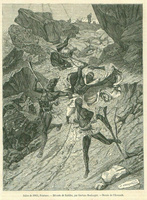
But a different image of Kabyles—showing men clad in loincloths—was featured in a painting exhibited by Boulanger at the Salon of 1863 and reproduced as a wood engraving in Le Magasin pittoresque.[103] La Déroute des Kabyles (The Defeat of the Kabyles) purported to represent a scene from the French military’s final conquest of Kabylia in 1857 (fig. 29). It shows Kabyle warriors on the verge of defeat: four men flee in terror down a ravine while small figures in French uniforms on the heights brandish weapons. One of the Berbers has fallen, but the other three race away. One wears a burnous that flaps behind him, but the others have stripped to loincloths, allowing them to move freely. Boulanger had spent time in Algeria as a young man and later as a traveler, and perhaps knew members of the French military stationed there, but the composition, which situates the viewer at the base of the gorge, was unlikely to have been based on his direct observation. Again, the contrast between the loincloths worn by the Kabyles and the uniforms of the French military underscores the cultural differences between the groups and emphasizes the Kabyles’ uncivilized nature.
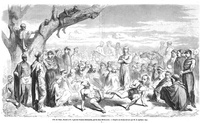
But there were circumstances in which Kabyle men removed their outer garments and stripped to a loincloth. After the French took control of Kabylia, L’Illustration published an image of a celebration of the “Fête de Tikar,” a martial-arts competition in which young men prepared for combat (fig. 30). In an open space at the center of a crowd of French and Kabyle men, a pair of wrestlers have stripped to loincloths to clash with their feet. The French observer, invoking racist tropes, likened the men to animals: “These half-naked men, their heads completely shaved, crawling like panthers, writhing like snakes, roaring like tigers, these men, I say, were truly admirable.”[104] At the left of the crowd, another young man stands, prepared to join the fray, his burnous falling open to show his loincloth.
The details of the life history of the man known in Parisian studios as “Salem, Prince de Tombouctou” remain hidden to us. We do not know where he was born or to which Algerian ethnic group he may have belonged, but he was considered Black by French and American artists and journalists. We do not know how he was recruited to serve as a tirailleur algérien in the Armée d’Afrique, and whether he fought in the Crimean War, as suggested by Niericker’s drawing, or joined later to participate in the Franco-Prussian War. Whenever it was that he enlisted, his opportunities to advance would have been circumscribed by military regulations and colonial ideologies. We do not know when he came to France, whether he posed for depictions of French battles, or how he came to work for Boulanger, and we can identify definitively only a few works for which he was the model. But posing in Parisian studios seems to have offered him—as it did other immigrants and perhaps other former tirailleurs algériens—an opportunity to establish a foothold in the capital. In contrast to Italian models, who were seen as modern embodiments of the beau idéal, however, Salem brought to Parisian studios and to French cultural production a presence perceived as alien and other. Cannily asserting his origins and exploiting French colonial ideologies, he presented himself as simultaneously exotic royalty and a hero who assisted in saving the French fatherland from German invaders. As an alien transplant to Parisian studio culture claiming a proud history, he may well have resisted artists’ requests that he accommodate a tradition in which masculine nudity was routine. Perhaps he and other Black models from North Africa insisted on maintaining a loincloth that, within Islamic traditions, signified both religious decorum and martial manliness—maintaining Islamic values and customs in the capital of colonial France. The loincloth worn by Black men in French artworks from the late nineteenth century should thus be seen not just as a sign of Western notions of the “primitiveness” of African cultures but as an assertion of Islamic traditions and the interface between Western and Islamic cultures in the context of French colonialism.
Acknowledgments
This essay originated in the generous invitation extended by Isolde Pludermacher and Scarlett Reliquet to participate in a symposium organized in May 2019 by the Columbia University Global Centers Paris Institute for Ideas and Imagination and the Musée d’Orsay in conjunction with the exhibition Le Modèle noir de Géricault à Matisse. Since then, it has gone through several revisions. It benefited considerably from comments and questions raised by participants in the roundtable “Race, Gender and Intermedia Art Practice in Transnational Paris, c. 1900,” organized in March 2021 by Emily C. Burns of the University of Oklahoma, David McAllister of the Birbeck Centre for Nineteenth-Century Studies, and Thomas Stammers of the Centre for Nineteenth-Century Studies at Durham University. I have also profited from suggestions offered in conversations with Mimi Weinberg, Julia Dabbs, Sean Kramer, Amanda Burdan, and Zaine Abdullah. Finally, I am most grateful for the advice offered by Petra Chu and two anonymous readers for Nineteenth-Century Art Worldwide.
Notes
All translations are by the author unless otherwise noted.
[1] Paul Dollfus, Modèles d’artistes (Paris: C. Marpon et E. Flammarion, 1888), 138, 140–41, 173, 178; and Paul Dollfus, “Paris qui Pose,” La Vie moderne, April 30, 1887, 274–77; May 7, 1887, 300–302; May 14, 1887, 313–14; May 21, 1887, 329–48.
[2] Hugh Honour, “Studies,” in The Image of the Black in Western Art, vol. 4, From the American Revolution to World War I, pt. 2, Black Models and White Myths, ed. David Bindman and Henry Louis Gates, Jr. (Cambridge, MA: Harvard University Press, 2012), 11–16, 35–36.
[3] Estelle Bégué and Isolde Pludermacher, “Les Modèles noirs dans le Paris du XIXe siècle du début du XXe siècle,” in Le Modèle noir: De Géricault à Matisse, ed. Céline Debray and Stéphane Guégan, exh. cat. (Paris: Musée d’Orsay; Flammarion, 2019), 194–210.
[4] Cat’zArts, L’École Nationale Supérieure des Beaux-Arts de Paris. The paintings and drawings after models produced for competitions are catalogued as “Figure peinte” (http://www.ensba.fr/) and “Figure dessinée d’après nature” (http://www.ensba.fr/). Discussing John Singer Sargent’s academic background, Erica C. Hirshler considers the anonymity of models in traditional practice. Erica C. Hirshler, “John Singer Sargent: Academician,” in Boston’s Apollo: Thomas McKeller and John Singer Sargent, ed. Nathaniel E. Silver, exh. cat. (Boston: Isabella Stewart Gardner Museum, 2020), 119.
[5] Claire O’Mahony, “Modern Muses: Representing the Life Model in Fin-de-Siècle France,” Art on the Line 1, no. 3 (2003), http://www.bristol.ac.uk/.
[6] Hugues Le Roux, “Le Monde des modèles,” La Vie artistique, April 28, 1889, 134–35; May 5, 1889, 142–43; and Charles Virmaître, Paris-Palette (Paris: A. Savine, 1888), 73–93.
[7] Eunice Lipton, Alias Olympia: A Woman’s Search for Manet’s Notorious Model and Her Own Desire (London: Thames and Hudson, 1993); Catherine Hewitt, Renoir’s Dancer: The Secret Life of Suzanne Valadon (Duxford, UK: Icon Books, 2019); and June Rose, Mistress of Montmartre: A Life of Suzanne Valadon (London: Richard Cohen Books, 1998).
[8] Denise Murrell, Posing Modernity: The Black Model from Manet and Matisse to Today, exh. cat. (New Haven, CT: Yale University Press; New York: Miriam and Ira D. Wallach Art Gallery, Columbia University, 2018); Debray and Guégan, Modèle noir; and Silver, Boston’s Apollo.
[9] Isolde Pludermacher, “Joseph,” in Debray and Guégan, Modèle noir, 84.
[10] Darcy Grimaldo Grigsby, “‘Whose colour was no black nor white nor grey, But an extraneous mixture, which no pen Can trace, although perhaps the pencil may’: Aspasie and Delacroix’s Massacres of Chios,” Art History 22, no. 5 (December 1999): 676–705, https://doi.org/10.1111/1467–8365.00182; and Bégué and Pludermacher, “Modèles noirs,” 198.
[11] Darcy Grimaldo Grigsby, “Still Thinking about Olympia’s Maid,” The Art Bulletin 97, no. 4 (December 2015): 430–51, https://www.jstor.org/stable/43947753; Griselda Pollock, “A Tale of Three Women: Seeing in the Dark, Seeing Double, at Least with Manet,” in Differencing the Canon: Feminist Desire and the Writing of Art’s Histories (London: Routledge, 1999), 255, 277–305; and Murrell, Posing Modernity, 7–83.
[12] Christine Barthe, “Models and Norms: The Relationship between Ethnographic Photographs and Sculptures,” in Facing the Other: Charles Cordier (1827–1905), Ethnographic Sculptor, ed. Laure de Margerie and Edouard Papet, exh. cat. (New York: Dahesh Museum of Art; Harry N. Abrams, 2004), 96–100. The list might also be expanded to include Thomas McKeller, an elevator operator who was hired by John Singer Sargent. See Silver, Boston’s Apollo.
[13] For a general history of French relations with and perceptions of Africa in the late nineteenth century, see Dieudonné Gnammankou, “1848–1889: Sauvages. De l’affranchi au sujet colonial,” in La France noire: Presences et migrations des Afriques, des Amériques et de l’océan Indien en France, ed. Pascal Blanchard et al., (Paris: Éditions La Découverte, 2011), 51–70, 234–36. On French Orientalist constructions of Blacks, see Adrienne Childs, “The Black Exotic: Tradition and Ethnography in Nineteenth-Century Orientalist Art” (PhD diss., University of Maryland, College Park, 2005); and Zain Abdullah, “The Art of Black Muslim Lives,” The Muslim World 110, no. 3 (Summer 2020): 274–309. On ethnographic representations, see Barthe, “Models and Norms”; Antoinette Le Normand-Romain, La Sculpture ethnographique: De la Vénus hottentote à la Tehura de Gauguin, exh. cat. (Paris: Réunion des Musées Nationaux, 1994); Hugh Honour, “The Art of Observation,” in Bindman and Gates, Image of the Black in Western Art, vol. 4, pt. 2, 47–56; and James Smalls, “Exquisite Empty Shells: Sculpted Slave Portraits and the French Ethnographic Turn,” in Slave Portraiture in the Atlantic World, ed. Agnes Lugo-Ortiz and Angela Rosenthal (Cambridge: Cambridge University Press, 2013), 283–312.
[14] Denise Murrell has revealed the development of a Parisian Creole culture among the immigrants from French colonies in the Antilles during the first half of the century. Murrell, “Olympia in Context,” Posing Modernity, 9–22, 49–52. Darcy Grimaldo Grigsby has explored the status of Black models in the Parisian wage economy after the second abolition of slavery in the French colonies in 1848. Grigsby, “Still Thinking About Olympia’s Maid.” Isolde Pludermacher and Estelle Bégué have pieced together names, addresses, and archival fragments to recover the precarious existence of Black models active in the late nineteenth and early twentieth centuries, drawing links between their employment in Parisian studios and other métiers—particularly popular-performance cultures. Finally, turning from France to the United States, Paul Fisher has examined how the racism of the Jim Crow era defined the careers of Sargent and McKeller. Paul Fisher, “‘Atlas, with the World on His Shoulders, This Was My Body’: Thomas McKeller and His Work with John Singer Sargent,” in Silver, Boston’s Apollo, 41–62.
[15] See E. P. Thompson, “History from Below,” Times Literary Supplement, April 7, 1966, 279–80. The term “art history from below” has been used by Marcus Rediker in a lecture “L’Esclave au Louvre/The Slave in the Louvre,” accessed November 4, 2016, https://www.canal-u.tv/.
[16] Edward Palmer Thompson, The Making of the English Working Class (New York: Pantheon Books, 1964), 12.
[17] On Jewish models, see Marie Lathers, “Posing the ‘Belle Juive’: Jewish Models in 19th-Century Paris,” Woman’s Art Journal 21, no. 1 (2000): 27–32, https://doi.org/10.2307/1358867; and Susan Waller, The Invention of the Model: Artists and Models in Paris, 1830–1870 (Aldershot, UK: Ashgate, 2006), 79–88. On Roma as models, see Susan Waller “Manet’s Model for The Bohemian (Fragment of The Gypsies),” Source: Notes in the History of Art 36, no. 1 (Summer 2016): 322–32, https://doi.org/10.1086/689197; and Marilyn R. Brown, “Manet’s Old Musician: Portrait of a Gypsy and Naturalist Allegory,” Studies in the History of Art, no. 8 (1978): 77–87, https://www.jstor.org/stable/42617902.
[18] “Beaux Arts,” L’Intransigeant, May 14, 1886, 3. My thanks to Martha Ward for bringing this reference to my attention. The original report remains unlocated. There were also, of course, a substantial number of male models in Paris at this time. In 1896 a census of Parisian industries and professions conducted by the Ministère du Commerce, de l’Industrie, des Postes et Télégraphes included models working in Paris; those enumerated were almost evenly split between men and women. See Ministère du Commerce, de l’Industrie, des Postes et des Telégraphes, Resultats Statistiques du recensement des industries et professions [Dénombrement de la population du 29 mars 1896], vol. 1, Région de Paris au nord et à l’est (Paris: Imprimerie Nationale, 1899), 294–95. For an overview of models in nineteenth-century Paris, see Billy Klüver and Julie Martin, “A Short History of Modeling,” Art in America 79, no. 5 (May 1991): 156–63, 183.
[19] Préfecture de la Seine, Service de la Statistique Municipale, Résultats statistiques du dénombrement de 1891 pour la ville de Paris et renseignements relatifs aux recensements antérieurs (Paris: G. Masson, 1894), lxxii–lxxvii, http://gallica.bnf.fr/.
[20] Préfecture de la Seine, Service de la Statistique Municipale, Resultats statistiques . . . de 1891, lxxv. On the Italian community of models, see Susan Waller, “Rodin and the modèle italien,” Sculpture Journal 27, no. 1 (2018): 77, 80–82, https://doi.org/10.3828/sj.2018.27.1.7.
[21] On Boulanger’s painting, see Salon des artistes français, Explication des ouvrages de peinture, sculpture, architecture, gravure et lithographie des artistes vivants, exposés au Palais des Champs-Élysées le 1er mai 1874 (Paris: Imprimerie nationale, 1874), 34. The painting was bought by Alexander Turney Stewart and was later sold in 1887 to S. A. Coate. See American Art Association, Catalogue of the A. T. Stewart Collection of Paintings, Sculptures, and Other Objects of Art, auction cat. (New York: American Art Association, 1887), 20, 264.
[22] Caroline Ticknor, May Alcott: A Memoir (Boston: Little, Brown, 1928), 164. I’m very grateful to Professor Julia K. Dabbs for her generosity in bringing the text on Salem to my attention and for sharing her research on May Alcott Niericker. See Julia K. Dabbs, “Black Subjectivity in the Life and Art of May Alcott Nieriker,” in The Forgotten Alcott: Essays on the Artistic Legacy and Literary Life of May Alcott Nieriker, ed. Azelina Flint and Lauren Hehmeyer (New York: Routledge, 2022), 182–85; and Julia Dabbs, May Alcott Nieriker, Author and Advocate: Travel Writing and Transformation in the Late Nineteenth Century (London: Anthem Press, 2022), 138–39.
[23] Ticknor, May Alcott, 164–65.
[24] Dabbs, “Black Subjectivity,” 182–85.
[25] École Nationale Supérieure des Arts Decoratifs, Comptabilité Reçus de Paiement des Modèles, AJ/53/171, Archives Nationales, Paris. On Salem at the École des Beaux-Arts, see Bégué and Pludermacher, “Modèles noirs,” 194–210. The registry is reproduced in Modèles noir, 211–17.
[26] Isolde Pludermacher, “Joseph,” 84.
[27] Works preserved in the archives of the École des Beaux-Arts are available in the database Cat’zArts, http://www.ensba.fr/.
The paintings and drawings after models produced for competitions are catalogued as “Figure peinte” (http://www.ensba.fr/) and “Figure dessinée d’après nature” (http://www.ensba.fr/). A black man named Venance posed in 1905 for photographs produced under the direction of Paul Richer as part of his anatomical studies. See L’Art du nu au XIXe siècle. Le Photographe et son modèle, exh. cat. (Paris: Hazan; Bibliothèque Nationale de France, 1997), 158, cat. no. 241.
[28] Le Nègre Scipion, ca. 1867, illustrated in Walter Feilchenfeldt, Jayne Warman, and David Nash, The Paintings, Watercolors and Drawings of Paul Cézanne: An Online Catalogue Raisonné, FWN 422, https://www.cezannecatalogue.com/ [login required]. See also Nicholas Mirzoeff, The Right to Look: A Counterhistory of Visuality (Durham, NC: Duke University Press, 2011) 174–75.
[29] Barclay Day, “Studio Life in Paris,” Magazine of Art, no. 5 (1882): 511.
[30] Mechthild Fend, Fleshing Out Surfaces: Skin in French Art and Medicine, 1650–1850 (Manchester, UK: Manchester University Press, 2017), 143–44, 172–74.
[31] Laure de Margerie, “‘The most beautiful Negro is not the one who looks most like us,’” in Facing the Other, 13–30; and Edouard Papet, “‘To have the courage of his polychromy’: Charles Cordier and the Sculpture of the Second Empire,” in Facing the Other, 51–82.
[32] For Loiseau-Rousseau’s Salem in Tervuren Park, see the photograph by Brigade Piron, accessed September 7, 2022, https://commons.wikimedia.org/.
[33] “Nos artistes et leurs modèles: Autour de la table de pose,” Lectures pour tous, April 1910, 644.
[34] “Ce Salem n’était-il pas le tambour major nègre portant le même nom que j’ai vu en 1870 à Nantes, à la tête d’un des bataillons de mobiles de la Loire-Infèrieure (qu’on appelait, je crois, le bataillon Candeau) et qui était, détail typique, coiffé d’un bonnet à poil blanc faisant ressortir sa noire et énergique figure? Salem prit part avec mon bataillon à la défense de Paris et s’y distingua assez pour obtenir la Légion d’honneur.” “Questions,” L’Intermédiaire des chercheurs et curieux, April 20, 1910, 561–62.
[35] Le Livre d’or des tirailleurs indigènes de la province d’Alger: Devenus 1er Régiment de Tirailleurs Algériens, (1866–1878) (Algiers: A. Jourdan, 1879), 3, 38, 51, 61, 63, 68, 89, 93, 180, 186, 194, 199; Jean Oudet, Le Livre d’or des tirailleurs indigènes de la province d’Alger: Ou, fastes et services des bataillons d’Alger et de Titheri, devenus le 1er Régiment de Tirailleurs Algériens (Algiers: Bastide, 1866), 90, 440, 602; Pierre-Paul-Jean-Jacques-Maurice Martin, Historique de 2e Régiment de Tirailleurs Algériens (Paris: H. Charles-La-Vauzelle, 1894), 228, 401; and Victor Duruy, Le Premier Régiment de Tirailleurs Algériens: Histoire et campagne (Paris: Hachette, 1899), 164, 184, 333, 337.
[36] On the history of tirailleurs algériens, see Anthony Clayton, France, Soldiers and Africa (London and Washington: Brassey’s Defence Publishers, 1988), 244–47; Elizabeth C. Childs, Daumier and Exoticism: Satirizing the French and the Foreign (New York: Peter Lang, 2005), 82–86; and Anthony Clayton and Paul Gaujac, Histoire de l’armée française en Afrique: 1830–1962 (Paris: Albin Michel, 1994), 300–2.
[37] Clayton, France, Soldiers and Africa, 199–200; Clayton and Gaujac, Histoire de l’armée française en Afrique, 245–49; and Neil MacMaster, Colonial Migrants and Racism: Algerians in France, 1900–62 (Basingstoke, UK: Palgrave Macmillan, 1997), 16.
[38] Clayton and Gaujac, Histoire de l’armée française en Afrique, 244.
[39] Clayton, France, Soldiers and Africa, 244; and Edouard Cat, Nos soldats d’Afrique (Paris: Librairie Gedelge, 1880), 97–99, 113–18.
[40] Clayton, France, Soldiers and Africa, 244; and Cat, Nos soldats d’Afrique, 99.
[41] Remy Valat, “Mourir à Bouzenval: Le Capitaine ‘Charles’ Abdelkader et les tirailleurs algériens pendant le siege de Paris (19 septembre 1870–28 janvier 1871),” Gavroche: Revue d’histoire populaire, no. 177 (January–March 2009): 23.
[42] Heinrich von Maltzan, “The Turcos,” Appleton’s Journal of Literature, Science and Art, March 11, 1871, 283–84; and Mark Lause, Soldiers of Revolution: The Franco-Prussian Conflict and the Paris Commune (New York, Verso: 2022), 65–66.
[43] Maltzan, “Turcos,” 283–84; and Cat, Nos soldats d’Afrique, 103–4, 107.
[44] Childs, Daumier and Exoticism, 83; and Cat, Nos soldats d’Afrique, 103–4.
[45] On French policy in Algeria, see Sandrine Lemaire, Pascal Blanchard, and Nicolas Bancel, “Milestones in Colonial Culture under the Second Empire (1851–1870),” in Colonial Culture in France Since the Revolution, ed. Pascal Blanchard et al. (Bloomington: Indiana University Press, 2014), 78–81.
[46] Clayton, France, Soldiers and Africa, 245–46; “Le temps des ‘turcos’ (1841–1913),” Diasporas en France, Groupe de Recherche ACHAC, accessed September 7, 2022, https://www.achac.com/; and “Ensemble. Présences maghrébines et orientales dans l’armée française: Premiers combats, premiers honneurs, 1848–1870,” Groupe de Recherche ACHAC, https://www.senat.fr/.
[47] Valat, “Mourir à Bouzenval,” 25–26; and Cat, Nos soldats d’Afrique, 110–11.
[48] Valat, “Mourir à Bouzenval,” 26–27. Some tirailleurs did participate, as documented by Daniel Vierge’s watercolor of 1871 of a tirailleur with the flag of the Commune, https://www.parismuseescollections.paris.fr/.
[49] MacMaster, Colonial Migrants and Racism, 38.
[50] Dollfus, Modèles d’artistes, 139, 177. The archives of the Légion d’honneur list the following men born in Algeria between 1775 and 1875 whose names include “Salem,” but most were not awarded the Légion d’honneur until after 1900: Salem ben Guerba (born 1835; named to the Légion d’honneur in 1872 [hereafter, an asterisk followed by a date indicates the date on which the individual was named to the Légion d’honneur]), https://www.leonore.archives-nationales.culture.gouv.fr/; Salem ben Ali (b. 1867; *1906), https://www.leonore.archives-nationales.culture.gouv.fr/; Abdel Kader Ben Salem (b. 1840; *1889), https://www.leonore.archives-nationales.culture.gouv.fr/; Ben Salem Aziz Ould Kaddour (b. 1860; *1904), https://https://www.leonore.archives-nationales.culture.gouv.fr/; Si el Hadj Salem dl Kadraoui (b. 1830; *1884), https://www.leonore.archives-nationales.culture.gouv.fr/; Salah Ben Salem Drioua, (b. 1873; *1913), https://www.leonore.archives-nationales.culture.gouv.fr/; Mohamed Ben Lamine Ben Salem Jennan (b. 1874; *1918), https://www.leonore.archives-nationales.culture.gouv.fr/; Mohamed Ben Messaoud Ben Salem Elkrim (b. 1855; *1902), https://www.leonore.archives-nationales.culture.gouv.fr/; Abderrahmane Ben Salem Atmane (b. 1855; *1898), https://www.leonore.archives-nationales.culture.gouv.fr/; and Ben Salem Ould Makhlar ben Alia Medjahri (b. 1853; *1901), https://www.leonore.archives-nationales.culture.gouv.fr/. See Base de données Léonore, Archives Nationales, Paris, https://www.leonore.archives-nationales.culture.gouv.fr/ui/.
[51] Childs, Daumier and Exoticism, 91.
[52] Valat, “Mourir à Bouzenval,” 101.
[53] Sylvie Chalaye, “Entertainment, Theatre and the Colonies,” in Blanchard et al., Colonial Culture in France, 121; and Maltzan, “Turcos,” 284.
[54] Chalaye, “Entertainment, Theatre and the Colonies,” 121.
[55] Barthe, “Models and Norms,” 92–111; and Le Normand-Romain, La Sculpture ethnographique, 15.
[56] Julia Thoma, The Final Spectacle: Military Painting under the Second Empire, 1855–1867 (Berlin: De Gruyter, 2019), 221–79; and Julia Thoma, “Panorama of War: The Salle de Crimée in Versailles,” Nineteenth-Century Art Worldwide 15, no. 1 (Spring 2016), http://www.19thc-artworldwide.org/.
[57] Thoma, Final Spectacle, 165–69; and Henry Jouin, Adolphe Yvon: Discours prononcé le 13 septembre 1893 au nom de l’École des Beaux-Arts . . . précédé de pages extraites des souvenirs inédits du peinture (Paris: “L’Artiste,” 1893), 50.
[58] Examples of studies that Yvon produced from tirailleurs algériens and French officers include Tête du capitaine Quinemant, commandant du 2e bataillon des Tirailleurs algériens, étude le tableau “La gorge de Malakoff” (Head of Captain Quinemant, Commander of the Second Batallion of Tirailleurs Algérians, Study for the Painting “The Gorge of the Malakoff”), drawing, Châteaux de Versailles et de Trianon, Versailles, https://www.photo.rmn.fr/; and Étude d’un buste de zouave tourné vers la gauche, les bras en avant et penché vers l’avant, pour “La Gorge de Malakoff” (Study for “The Gorge of the Malakoff” of a Bust of a Zouave Turned to the Left, Arms Extended and Leaning Forward), drawing, Châteaux de Versailles et de Trianon, Versailles, https://www.photo.rmn.fr/. Note that although the title given the latter work identifies the figure as a Zouave, the notes in the entry for the work in L’Agence Photo RMN/Grand Palais (see link directly above) identify him as tirailleur Tahar ben Marouf. On Yvon’s concern for accuracy in his military works, see Jouin, Adolphe Yvon, 50.
[59] Thoma, Final Spectacle, 202; Albert Boime, Art in an Age of Civil Struggle, 1848–1871 (Chicago: University of Chicago Press, 2008), 608–10; and Childs, Daumier and Exoticism, 85.
[60] As quoted in Thoma, Final Spectacle, 207.
[61] Hollis Clayson has suggested that a tirailleur might have posed for Orientalist works which Henri Regnault (1843–1871) produced while stationed in Paris during the Franco-Prussian War, though she notes that since the name of the model is not noted there is no way to confirm this. Hollis Clayson, “Henri Regnault’s Wartime Orientalism,” in Orientalism’s Interlocutors: Painting, Architecture, Photography, ed. Jill Beaulieu and Mary Robert (Durham, NC: Duke University Press, 2002), 155–56.
[62] Companies of tirailleurs sénégalais were formed in 1857 at the urging of Louis Faideherbe, but they would not participate in conflicts outside of Africa until World War I, so it is unlikely that Salem’s origins were in West Africa. Clayton and Gaujac, Histoire de l’armée française, 408–12.
[63] Champfleury, Les Excentriques, nouvelle éd. (Paris: M. Lévy Frères, 1856), 256.
[64] Virmaître, Paris-Palette, 83–84; and Bertall, La Vigne, voyage autour des vins de France: Étude physiologique, anecdotique, historique, humoristique et même scientifique (Paris: E. Plon, 1878), 46–55.
[65] Bégué and Pludermacher, “Modèles noirs,” 202; Virmaître, Paris-Palette, 85; and Edmond Desbonnet, Les Rois de la force: Histoire de tous les hommes forts depuis les temps anciens jusqu’à nos jours (Paris: Librairie Athlétique, 1911), 138–39, 144–55. An advertisement for the Cirque d’Hiver in which Bamboula, “le negre du Senegal,” is listed appears in L’Orchestre: Revue quotidienne des théâtres, February 1, 1883, n.p.
[66] Émile de La Bédollière, “Le Modèle,” in Les Francais peints par eux-mêmes: Encyclopédie morale du dix-neuvième siècle, vol. 2 (Paris: L. Curmer, 1841), 6.
[67] “Variétés: Le testament de Charles Alix Dubosc: Souvenirs d’atelier,” L’Illustration, January 27, 1877, 59.
[68] For a general history of French colonial enterprise, see Robert Aldrich, Greater France: A History of French Overseas Expansion (Basingstoke, UK: Macmillan, 1996), 13–16, 22–23.
[69] Tor A. Benjaminsen, Gunnvor Berge, and Erling Dugan, “Myths of Timbuktu: From African El Dorado to Desertification,” International Journal of Political Economy 34, no. 1 (2004): 31–59, https://www.jstor.org/stable/40470861; and Richard L. Smith, “The Image of Timbuktu in Europe before Caillié,” Proceedings of the Meeting of the French Colonial Historical Society 8 (1985): 12–22, https://www.jstor.org/stable/42952125.
[70] Smalls, “Exquisite Empty Shells,” 283–312. On Enkess, see also Margerie and Papet, Facing the Other, 99–100, 112, 126–27, 129, 203–4; and Jan Marsh, “Pictured at Work: Employment in Art (1800–1900),” in Belonging in Europe: The African Diaspora in Europe, ed. Caroline Bressey and Hakim Adi (London: Taylor and Francis, 2013), 203.
[71] Smalls, “Exquisite Empty Shells,” 293–94. See also Honour, “Art of Observation,” 92–123.
[72] Dabbs, “Black Subjectivity,” 182–85.
[73] Clara H. Stranahan, A History of French Painting from Its Earliest to Its Latest Practice (London: Sampson Low, Marston, Searle, and Rivington, 1889), 319–21, 329.
[74] René Menard, “Gustave Boulanger,” The Portfolio, January 1875, 178–80; and Stranahan, History of French Painting, 319–20.
[75] Jean Rousseau, “Le Salon,” Le Figaro, May 16, 1874, 1; and Paul de Saint-Victor, “Salon de 1874,” La Liberté, May 23, 1874, n.p.
[76] For example, see https://commons.wikimedia.org/.
[77] Adrienne L. Childs, “Exceeding Blackness: African Women in the Art of Jean-Léon Gérôme,” in Blacks and Blackness in European Art of the Long Nineteenth Century, ed. Adrienne L. Childs and Susan H. Libby (Farnham, UK, and Burlington, VT: Ashgate, 2014), 125–44; and Childs, “Black Exotic,” 82–140.
[78] Jutta-Annette Bruhn, Coins and Costume in Late Antiquity (Washington, DC: Dumbarton Oaks Research Library and Collection, 1993), 26–30. My thanks to Mimi Weinberg for suggesting this association.
[79] On “blackamoors” in the decorative arts, see Paul Kaplan, “Visual Sources of the ‘Blackamoor’ Statue,” in ReSignifications. European Blackamoors, Africana Readings, ed. Awam Amkpa (Rome: Postcart, 2017), 49–60; and Adrienne L. Childs, “A Blackamoor’s Progress: The Ornamental Black Body in European Furniture,” in Amkpa, ReSignifications, 117–28. The costume worn by “blackamoors” has also been linked to representations of Native Americans in sixteenth-century travel accounts. See Helmut Nickel, “The Graphic Sources for the Moor with the Emerald Cluster,” Metropolitan Museum Journal 15 (1981): 203–10.
[80] Adrienne L. Childs, “Sugar Boxes and Blackamoors: Ornamental Blackness in Early Meissen Porcelain,” in The Cultural Aesthetics of Eighteenth-Century Porcelain, ed. Alden Cavanaugh and Michael E. Yonan (Farnham, UK: Ashgate, 2010), 159; and Adrienne L. Childs and Susan Libby, “European Art and the Possibilities of Blackness,” in The Black Figure in the European Imaginary, exh. cat. (Winter Park, FL: Cornell Fine Arts Museum, Rollins College; London: D. Giles, 2017), 37.
[81] Mary Guyatt, “The Wedgwood Slave Medallion: Values in Eighteenth-Century Design,” in Journal of Design History 13, no. 2 (2000): 93–105, especially 99–101 on the ideological implications of the enslaved figure’s stance, https://www.jstor.org/stable/3527157; and Luce-Marie Albigès, “Le cachet de la Societé des Amis des Noirs,” Histoire par l’image, October 2006, http://histoire-image.org/.
[82] Maria P. Gindhart, “Ethnographic Exoticism: Charles-Arthur Bourgeois’s Snake Charmer,” Material Culture Review/Revue de la culture matérielle 79 (Spring 2014): 7–23; and Antoinette Le Normand-Romain, “Sculpture et ethnographie,” in Sculpture ethnographique, 33–50.
[83] On Yvon’s work, see American Art Association, Catalogue of the A. T. Stewart Collection of Paintings, Sculptures, and Other Objects of Art, 20; and Thomas B. Brumbaugh, “The Genius of America: Adolphe Yvon’s Remarkable Picture,” Southeastern College Art Conference Review 11, no. 1 (Spring 1986): 9–13. A reduced version of The Genius of America is in the collection of the Saint Louis Art Museum. On the monument to Schoelcher, see Hugh Honour, “Memorials—Or the Glory of Empire,” in The Image of the Black in Western Art, vol. 4, pt. 1, Slaves and Liberators, ed. David Bindman and Henry Louis Gates, Jr. (Cambridge, MA: Harvard University Press, 2012), 269–70.
[84] Philippe Grunchec, The Grand Prix de Rome: Paintings from the École des Beaux-Arts, 1797–1863, exh. cat. (Washington, DC: International Exhibitions Foundation, 1984–85), 139–44.
[85] See Pludermacher, “Joseph,” 88–89; and Honour, “Studies,” 43–45.
[86] On the issue of veiling male genitals, see also Anthea Callen, Looking at Men: Anatomy, Masculinity and the Modern Male Body (New Haven, CT: Yale University Press, 2018), 70–71. On Moreau’s practice, see Geneviève Lacambre, Larry J. Feinberg, Marie-Laure de Contenson, and Douglas W. Druick, Gustave Moreau: Between Epic and Dream, exh. cat. (Paris: Réunion des Musées Nationaux, 1999), 78–89, 136–53. On Bouguereau’s practice, see Kara L. Ross, “William Bouguereau’s Nymph and Satyr,” in Damien Bartoli and Frederick C. Ross, William Bouguereau: His Life and Works (Woodbridge, NY: Antique Collectors’ Club, 2010), 492–95; and Louise d’Argencourt, “La Jeunesse de Bacchus: The Influence of Greco-Roman Art,” Sotheby’s, April 30, 2019, https://www.sothebys.com/.
[87] Tamar Garb, Sisters of the Brush: Women’s Artistic Culture in Late Nineteenth-Century Paris (New Haven, CT: Yale University Press, 1994), 75, 88–95; and Tamar Garb, “The Forbidden Gaze: Women Artists and the Male Nude in Late Nineteenth-Century France,” in The Body Imaged: The Human Form and Visual Culture since the Renaissance, ed. Kathleen Adler and Marcia Pointon (Cambridge: Cambridge University Press, 1994), 33–42, 193–94.
[88] Larissa Bonfante, “Nudity as a Costume in Classical Art,” American Journal of Archaeology 93, no. 4 (October 1989): 543–70, https://doi.org/10.2307/505328.
[89] Jill Burke, “The European Nude, 1400–1650” in Splendor, Myth and Vision: Nudes from the Prado, ed. Thomas J. Loughman, Kathleen M. Morris, and Lara Yeager-Crasselt, exh. cat. (Williamstown, MA: Clark Art Institute; Madrid: Museo Nacional del Prado; New Haven, CT: Yale University Press, 2016), 18–20, 23–24.
[90] Sara Omar, “Dress,” in The [Oxford] Encyclopedia of Islam and Law. Oxford Islamic Studies Online, accessed October 24, 2022, https://www.academia.edu/ [login required].
[91] Yūsuf Qaraḍāwī, The Lawful and the Prohibited in Islam (Al-Halal wal-haram fil Islam), trans. Kamal El-Helbawy, M. Moinuddin Siddiqui, and Syed Shukry; translation reviewed by Ahmad Zaki Hammad (Indianapolis: American Trust Publications, 1980), 154.
[92] Yedida Kalfon Stillman, Arab Dress: From the Dawn of Islam to Modern Times, ed. Norman A. Stillman (Leiden and Boston: Brill, 2000), 10–11, http://islam-and-muslims.com/Arab-Dress-History.pdf.
[93] Stillman, Arab Dress, 10.
[94] Stillman, Arab Dress, 7, 10–11.
[95] Stillman, Arab Dress, 88–89.
[96] “Ils sont uniformément vêtus d’un caleçon et d’une draperie en cotonnade écrue qui laisse habituellement la partie haute du corps à découvert.” H. A. Mazard, “Nouvelles et Correspondance: Jardin d’Acclimatation de Paris – Les Nubiens,” in Muséum de Toulouse, Matériaux pour l’histoire primitive et naturelle de l’homme (Paris: C. Reinwald, 1877), 343. See also Eric Baratay, Elisabeth Hardouin-Fugier, and Oliver Welsh, Zoo: A History of Zoological Gardens in the West (London: Reaktion Books, 2004), 127–28.
[97] “Leur habillement se compose 1. Du haïk . . . dont un des quatre bouts est jeté par-dessus la tête et attache avec un cordon (reit) fait de poil de chameau; 2. du burnous, espèce de manteau large, de laine blanche et d’une seule pièce, il est garni d’un capucin servant à couvrir la tête, rasée partout, à l’exception du sommet, surmonte d’une touffe de cheveux. Il ne ya a que les riches qui portent un pantalon large, allant jusqu’aux genoux. Les bras et les pieds sont découverts: quelques tribus, cependant, se chaussent d’une espèce de sandales.” R. Jungmann, Costumes, moeurs et usages des Algériens (Strasbourg: J. Bernard, 1837), 15–16.
[98] Patricia M. E. Lorcin, Imperial Identities: Stereotyping, Prejudice and Race in Colonial Algeria (London: I. B. Tauris, 1995), 18–27.
[99] Lorcin, Imperial Identities, 17–18, 25–28.
[100] “Le Kabyle, par la neige ou le soleil, a généralement la tête nue. Ceux qui avoisinent les plaines portent quelquefois la chachia. Il a pour tout vêtement une espèce de chemise de laine (chelouhha) qui dépasse les genoux, et porte le burnous quand ses moyens lui permettent.” Jules Rigo, “Les types de tribus Kabyles,” Le Monde illustré, June 13, 1857, 13–14. Similar descriptions of the Kabyle costume can be found in Georges Marçais, Le Costume Musulman d’Alger (Paris: Librairie Plon, 1930), 14–30; Adolphe Hanoteau and Aristide Letourneux, La Kabylie et les coutumes kabyles, 2nd ed. (Paris: Augustin Challamel, 1893), 411; and Thomas Cook (Firm), Practical Guide to Algiers, Algeria and Tunisia (London: T. Cook, 1904), 206–7.
[101] Émile Carrey, Récits de Kabylie: Campagne de 1857 (Paris: Michel Lévy Frères, 1858), 43, 48, 50, 69, 72, 118, 119, 125, 292.
[102] “Expedition de la petite Kabylie,” L’Illustration, June 7, 1851, 1.
[103] “Les Kabiles,” Le Magasin pittoresque, January 1, 1863, 273–76.
[104] “Ces hommes demi-nus, la tête complètement rasée, rampant comme des panthères, se tordant comme des serpents, rugissant comme des tigres, ces hommes, dis-je, étaient réellement admirables.” “Fête du Tikar,” L’Illustration, November 21, 1857, 340–41. On tikar, also spelled tiqqar, see S. A. Boulifa, “Jeux en Kabylie au début du XXe siècle,” Encyclopédie berbère, no. 25 (2003): 3874–90, https://doi.org/10.4000/encyclopedieberbere.1503.